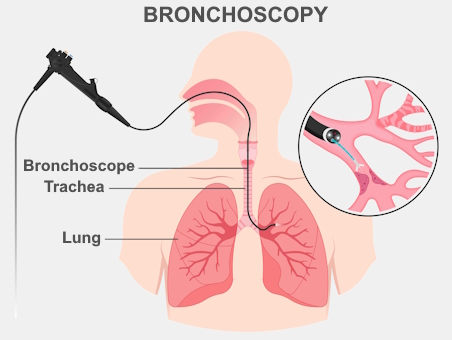Bronchoscopy Whakamātaunga pūkahukahu
Bronchoscopy is a procedure to examine your airways — your voice box, throat and the air passages and linings inside your lungs. Bronchoscopy uses a long flexible tube with a light and camera at the tip, called a bronchoscope.
When you would have a bronchoscopy
You might have a bronchoscopy to investigate and diagnose conditions affecting your airways. This could include:
- looking for the cause of a cough or infection that is not getting better
- investigating unexplained breathing problems
- helping diagnose something unusual seen on a chest x-ray or scan.
Bronchoscopy can also be used to remove foreign objects from your airways — perhaps something you breathed in accidentally.
Having a bronchoscopy
The bronchoscope is passed into your airways by the specialist doctor, either through your nose or your mouth. You will usually be given a sedative during the procedure to help you feel more comfortable.
The specialist doctor doing the bronchoscopy will be able to see the linings of your airways.
During the procedure, the specialist doctor may take small samples (biopsies) of tissue from your airways or lungs through the bronchoscope. These samples are sent to a laboratory to help with the diagnosis. You will not feel this, and it will not damage your airways or lungs.

A bronchoscope passes down the airway (trachea) into the lung. Tissue samples can be collected through the end of the bronchoscope.
Before your bronchoscopy
You will be sent an appointment for your bronchoscopy. Before your appointment, it is important to tell your healthcare provider and specialist doctor about any medications you are taking.
You may need to stop some of your regular medicines either before or on the day of the bronchoscopy. Your specialist doctor will give you information about this. If you are not sure, speak to your healthcare provider.
If you are having a sedative you will not be able to have anything to eat or drink for 4 hours before your bronchoscopy.
After your bronchoscopy
After your bronchoscopy you may have:
- a sore throat
- a hoarse voice
- slight nosebleed.
If biopsies were taken you might find streaks of blood in your phlegm. This will usually stop within 24 hours.
Having sedation during a bronchoscopy means small amounts will remain in your body for the next 24 hours.
If you have been given a sedative, it can make you forgetful and impair your judgement and reflexes. Even if you feel alert, you must not do any of the following for 24 hours:
- drive
- operate machinery
- drink alcohol
- sign any legal documents
- ride on public transport alone.
Results of your bronchoscopy
Results from the laboratory can take a few days to come through. For some tests, they may take a few weeks.
Your specialist team will discuss with you what they saw through the bronchoscope and any biopsy results. They will also explain what they mean.
The results will also be sent to your healthcare provider to discuss them with you.
Risks of bronchoscopy
Bronchoscopy is generally very safe. But like all medical procedures there are some possible risks. For bronchoscopy, these risks include:
- bleeding, especially if tissue samples were taken
- infection leading to pneumonia
- making a hole in a lung or another part of your airways — this can cause a collapsed lung (pneumothorax) or air getting into parts of your body where it should not be
- irritated airways including your voice box — this could give you a hoarse voice for a while.
Healthcare services may be provided to you only if you make an informed choice and give informed consent to it. This forms part of your rights (Rights 5, 6 and 7) under the Code of Health and Disability Services Consumer Rights (the Code).
The Code and Your Rights/Ōu Mōtika — Health & Disability Commissioner
The 3 rights that together allow for informed consent are:
- Right 5 — the right to effective communication
- Right 6 — the right to be informed
- Right 7 — the right to choice and consent.
This means you must be told about the service being suggested, including any risks or possible complications. You must have the chance to ask as many questions as you need to understand the information you are given.
You also have the right to have someone with you to help you. But the decision to say 'yes' or 'no' must be yours (unless you are unable to make that decision due to illness or other impairment, or sometimes in an emergency).
You also have the right to be given the information in a language you fully understand. You can ask for an interpreter if you need one.
Referral information
You will need to be referred to a specialist doctor (a gynaecologist) by your healthcare provider. You cannot self-refer.
This procedure can be done in the public health system or privately.